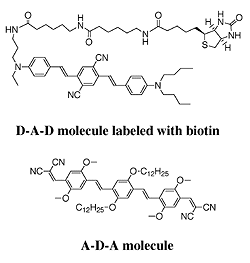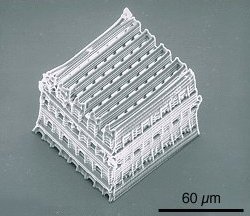An infrared laser can make acid at a single point when it is tightly focused in a polymer resin developed by US researchers. The research demonstrates for the first time the possibility of engineering molecules so that they efficiently absorb two particles of light, or photons, and efficiently trigger a chemical change.
Seth Marder and Joseph Perry of the University of Arizona in Tucson have developed new molecules that generate acid at the focus of a near-infrared laser beam. The intensity of a laser is highest at the focus and falls off quadratically with distance from the focus, explains Marder. Two photon absorption, however, scales quadratically with intensity and therefore falls off at the fourth power of distance from the focus.

Seth Marder
This means the researchers can pinpoint very precise locations. The technique could be used to sculpt three-dimensional structures on the microscale for use in making microelectromechanical devices, tiny medical devices, and in optical information technology for a future optical molecular computer.
Chemists Marder and Perry have for several years been working to design and synthesise molecules that are able to absorb two photons at once. More importantly though, the team has now managed to incorporate a reactivity into these dye molecules so that when they absorb two, and only two photons of appropriate energy, the molecules end up in a higher energy state. In this excited state they can activate chemical reactions by transferring their electrons to another part of the molecule and causing the break-up of that part to produce reactive fragments including acid.

Molecular structures
The two-photon absorbing molecules designed by the team are thus known as photoacid generators. Until now, photoacid generators have been ineffectual under two-photon excitation with near infrared lasers and have found little technological application. Acid is one of the most ubiquitous reagents in chemistry, Marder explains. Protons (hydrogen ions, the simplest acid) can be used to start reactions that string monomers together to make polymers, or rip polymers into smaller fragments, or change solubility. We now have the ability to put protons anywhere in materials with three-dimensional pinpoint control afforded by the two-photon-absorption process.

Microstructures of interest in photonics and sensing, such as the stack-of-logs photonic crystal can be created using the two-photon absorbing molecules (Credit: JW Perry, U Arizona)
The Arizona molecules are up to a few hundred times more sensitive for two-photon absorption than their one-photon predecessors, which relied on destructive ultraviolet light for their excitation. Working with Christopher Ober and Tianyue Yu at Cornell University, the team has developed specially designed resins that can be etched away after exposure to acid.

Joseph Perry
The possibility of etching a resin solid containing embedded two-photon molecules will open the way to three-dimensional microfabrication by allowing specific points in a resin block to be activated, release protons and so etch a hole or channel inside the block. To demonstrate their prowess the team created networks of microchannels, as well as free-standing microstructures, by exposing solid resins of the new materials to the laser beam.
The two-photon molecules are added in low concentration, about one percent, to a polymer starting material to make a resin block. The acid generation process can then be used to manipulate the resin, changing its properties, etching holes or channels or even changing its transparency or making it mechanical stronger. The two-photon process can also be used to change the solubility of the resin so that it becomes soluble in water or organic solvents.
Imagine that we start with a plastic, totally impervious to water, says Perry. We can wash it all day and nothing happens. We scan with the laser, protons nip off parts hanging from the side of the polymer, and now there are polymer chains that can be dissolved in water. Instead of ending up with a little framework of stick-like structures, we have a bunch of little channels buried in the object. He adds, From an architectural point of view, it’s the difference between erecting a building or digging a mine. If all you want to do is dig a mine, you don’t want to have to build the mountain first just so you can tunnel.
The researchers also point out that the process could be used in photodynamic therapy in medicine to change the acidity, the pH, of specific points in the body, bursting open an injected drug capsule using a near infra-red laser focused at the target site, a tumour, for instance. The University of Arizona scientist have formed a company, Focal Point Microsystems, to commercialise this and related two-photon technology.
Further reading
Seth Marder
http://www.chemistry.gatech.edu/faculty/Marder/
Joseph Perry
http://www.chemistry.gatech.edu/faculty/Perry/
Christopher Ober
http://people.ccmr.cornell.edu/~cober/
Suggested searches
Photonics
Two photon excitation